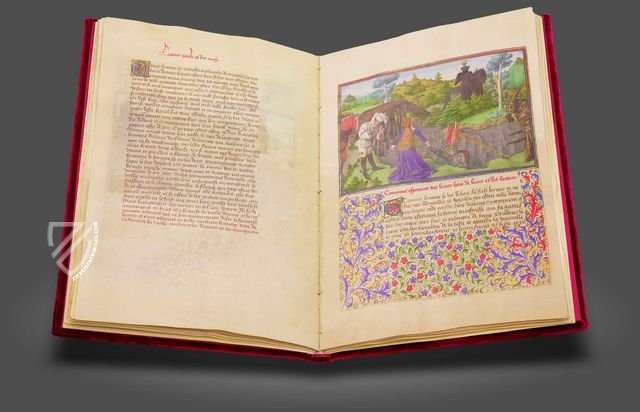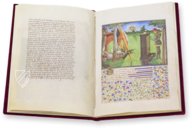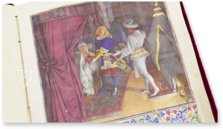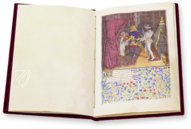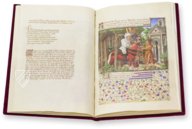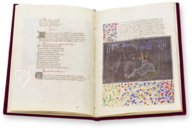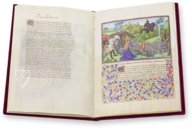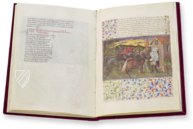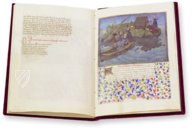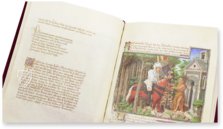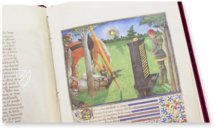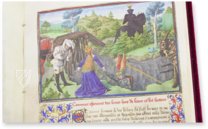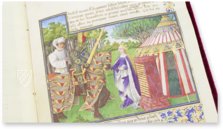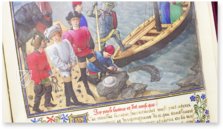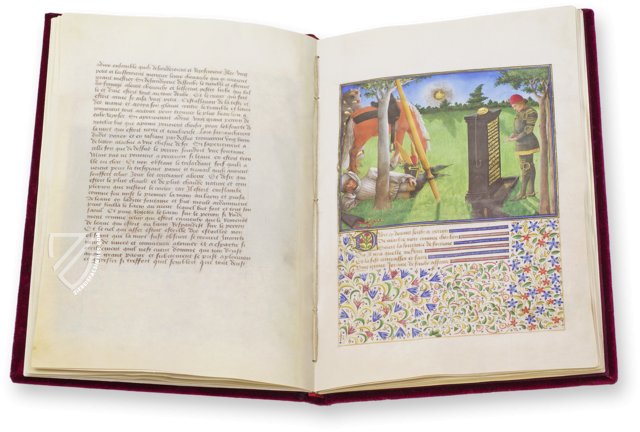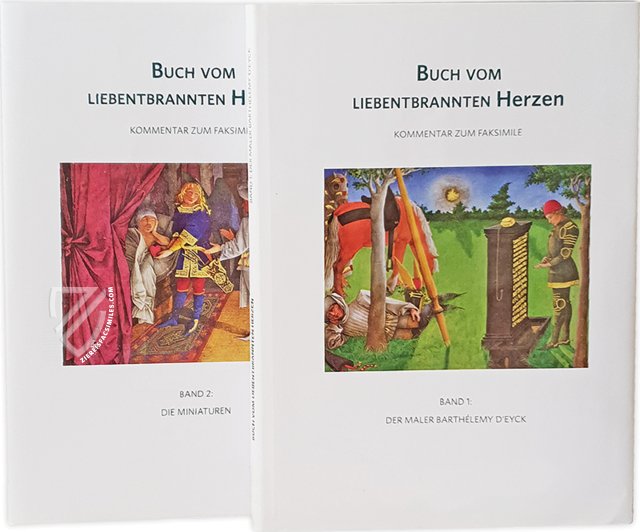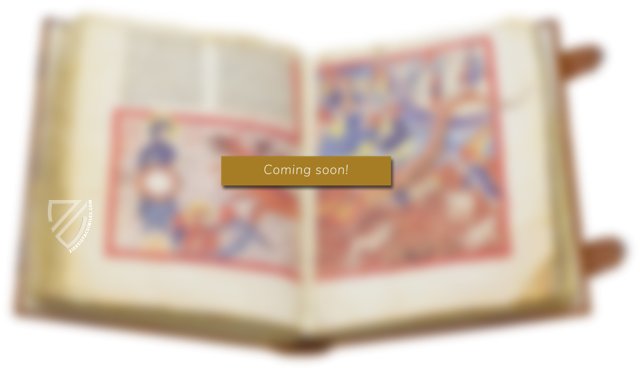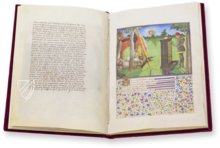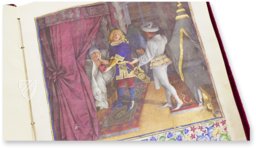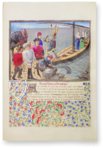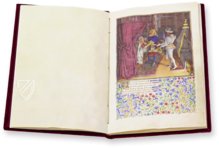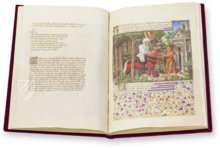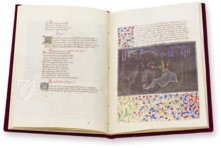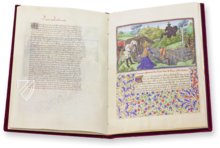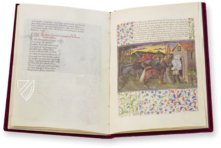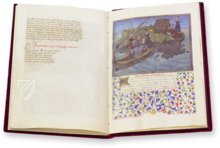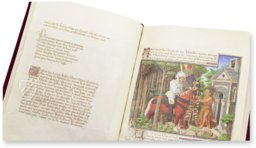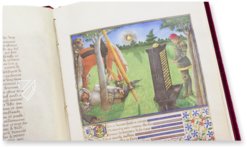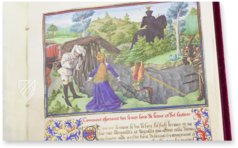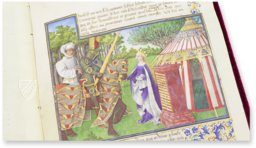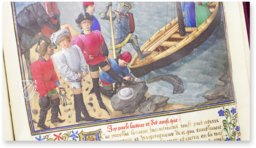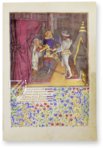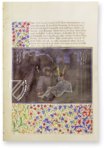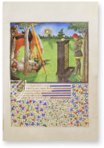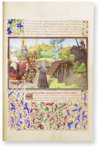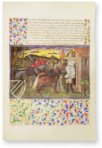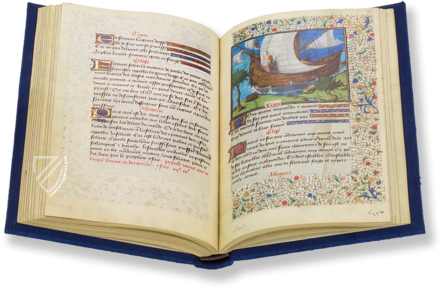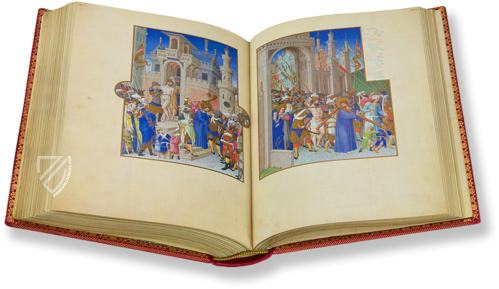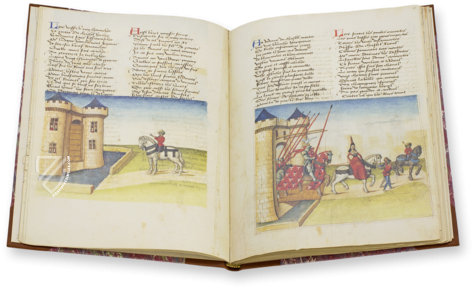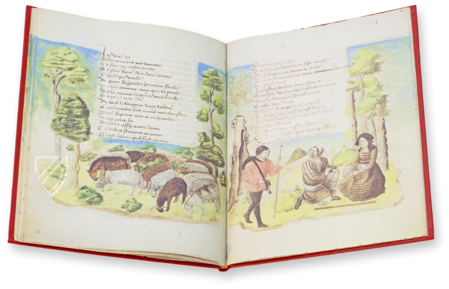King René's Book of Love
(3,000€ - 7,000€)
Renè d’Anjou tried more than most to fulfill the chivalric ideal, he was a powerful nobleman with an artistic soul who stands out among the tragic figures of medieval history, not only because he experienced personal tragedy and saw his own dynasty decline during his lifetime, but because he was an author capable of producing a bitter-sweet chivalric romance worthy of remembrance. In 1457, he completed Le Livre du Cuer d'amours espris or The Book of the Love-Smitten Heart, a work that resulted from the heartfelt loss of his wife and whose bitter-sweet events mirror those of Renè himself. He was assisted in this labor by his longtime court painter, friend, and personal attendant Barthélemy d'Eyck, who was already recognized in his day to be a master miniaturist. Of Dutch origin, Barthélemy was active in France and Burgundy during the mid–15th century and is associated with some of the greatest works of that period both as a miniaturist and as a panel painter. The original codex is stored in Vienna’s Österreichische Nationalbibliothek under the shelf mark Ms. 2597, and is considered to be the oldest and most beautiful of the 6 Le Livre du Cuer d'amours espris manuscripts known to be in existence.
The Book of the Love-Smitten Heart
As hard as it may be to believe for some people today, the chivalric ideal was actually something that many aspired to during the Middle Ages. It was this ideal that elevated a thuggish knight to a warrior poet, and few embodied this ideal more than René d´Anjou. As France emerged wounded but victorious and reinvigorated from the Hundred Years’ War, this was reflected artistically by a flowering of art and a golden age of French illumination. This was the age of Renè d’Anjou. A lover of grand tournaments, feasts, and Arthurian romance, his life was like something out of a fairytale, for better and for worse. This extraordinary member of the upper-aristocracy of the Late Middle Ages was an author, a poet, and a painter, aside from being Duke of Anjou, Lorraine, and Bar, Count of Provence, Maine and Piedmont, and King of Naples and Sicily. A splendid tournament book full of detailed depictions of armor and escutcheons is among his splendid works, but his greatest achievement was arguably the Le Livre du Cuer d'amours espris or The Book of the Love-Smitten Heart, which he finished in 1457 and had illuminated by Barthélemy d'Eyck. This codex is not only significant for the fact that is contains a chivalric romance penned by a high-ranking nobleman, but because of its outstanding miniatures – considered to be some of the finest in the entire canon of medieval illumination. Le Livre du Cuer d'amours espris thus considered to be one of the highlights of medieval book culture.
Finding Inspiration in Sorrow
Like many artists, his Le Livre du Cuer d'amours esprisinspired by a tragic loss, the death of his dearly-beloved wife Isabella, but like many men, he first channeled his sadness into an emotion that men are more comfortable with: anger. After the death of his wife Isabella of Lorraine in 1453, Renè channeled his mourning into a military campaign in Italy that was ultimately futile. Unable to express himself martially, he returned to France in 1454 where remarried, settled back into life at Angers, and poured his heart and soul into a work that is considered to be the descendant of the famous Roman de la Rose. Completed in 1457, the The Book of the Love-Smitten Heart is an allegorical chivalric romance composed in a combination of prose and verse in which all the figures are representations of feelings, attitudes, virtues, or vices. The story begins with a dream/vision when the poet’s heart, personified by the knight Cuer, is stolen by Cupid and given over to Desire. Renè awakes, checking his left side to see if his heart is indeed gone, and calls for his valet to bring him pen and paper so that he may record his dream.
A Man of Many Titles
Born at the fortress of Angers in 1409, Renè d’Anjou playe an important role during the critical and turbulent period of 14th century Franco-Italian history. He participated in the final period of the Hundred Years’ War and was a key figure in the dynastic disputes which lead to the Italian Wars. Originally, he was only entitled to the title of Duke of Bar through his mother and Duke of Lorraine through his wife, which made him a wealthy and mighty lord to be sure, but the death of his older brother propelled Renè into the highest caste of medieval society. He was now the sovereign of the Counties of Maine and Provence, and the Duchy of Anjou in addition to now being entitled to the Kingdom of Naples and Sicily, and became a major political player as a result. All these incredible titles left him overextended, especially his royal claims. He was in the captivity of the Duke of Burgundy when he came inherited his Sicilian crown in 1435, and it was during this captivity that he displayed his creative bend for the first time as he occupied himself with the painting of an entire room in the fortress of Dijon as well as the painting of stained glass. Finally able to visit his Italian domains in 1438, he had to abandon them by 1442 due to a combination of their distance from his homeland, the resistance of the locals, and the contending claim of King Alfonso V of Aragon. This proved to be a blessing as it allowed him to return to his beloved France and focus on the administration of his extensive lands there.
A Life of Chivalric Romance
Renè d’Anjou lived like a character from a medieval romance: inheriting unexpected greatness, participating in momentous wars, enduring captivity, enjoying great love, and suffering great loss as his dynasty’s fortunes declined. During this time, he also arranged the marriage of his daughter Margaret with King Henry VI of England, and thus his daughter became entangled in the Wars of the Roses in England. The decade following his return from Naples was spent living the idyllic life of a chivalrous lord, wisely and benevolently administering his domains while enjoying and writing romantic poetry and song, as well as hosting the most lavish tournaments in the land. This joyous period came to an end with the death of his wife Isabella in 1453, after which it is said Renè was inconsolable. This deep well of emotion was channeled into the moving story of The Book of the Love-Smitten Heart, and with the help of Jeanne de Laval, his young new wife, the joy of love gradually began to reenter his life. This was not his only personal loss, as two sons of his died while caught up in the struggle for the Crown of Aragon, both presumed poisoned. Although he never quite returned to public life to his previous degree and the power of his dynasty diminished, he found solace in love and art once again, and split most of his time between Angers and Saumur until 1471 when he retired to Provence – with his impressive library in its entirety – where he remained until his death in 1480. Renè knew a life of love and loss, he was, in many ways, the hero of his own chivalric romance, complete with the characteristic twinge of tragedy.
Le Livre du Cuer d'amours espris: The Story of a Quest
Cuer the knight, representing the lost heart of the lover, is accompanied on his adventures by a squire subtly-named Ardent Désir (Burning Desire), in order to free Dame Doulce-Mercy (Sweet Thanks), who is imprisoned in the Manior de Rebellion (Castle of Rebellion) by here three jailors, Reffus, Honte, and Crainte representing refusal, shame, and fear respectively. Before reaching this place, the hero comes to the Hospital d’Amours where he is warmly received by the prioress Pitié. In the sickroom of the hospital of love, Cuer encounters just about every famous lover from history, myth, and literature. After receiving cupid’s blessing, Cuer and his squire are able to free Dame Doulce-Mercy from her jailors. However, while on the way to cupid’s palace accompanied by Desir, Humble-Request, and Pitiè, he is attacked once again by all his enemies, Cuer is wounded, Desir is slain, and Doulce-Mercy is recaptured. Pitiè cares for the wounds of Cuer and tries to console him, telling him that he must think no more of Doulce-Mercy, because she is forever in the power of Reffus. Cuer must then spend the rest of his days in the Hospital d’Amours in prayer and loving memory of Doulce Mercy. Considering the circumstances of the author’s life at the time – mourning the loss of a wife and trying to find love again with another while also mourning the equally irrevocable loss of a kingdom – the melancholy and bitter-sweet tone of the story, the ending in particular, make complete sense.
Barthélemy d'Eyck: The Master of Shadows
Barthélemy d'Eyck, originally Barthélemy van Eyck as he was of Dutch origin, was an incredibly talented painter and miniaturist who was primarily active in France and Burgundy during the mid–15th century. He was already recognized as the one of the greatest artists of his time by his contemporaries and is believed to have contributed to famous works like the Aix Annunciation and the Très Riches Heures du Duc de Berry, in addition to his work for Renè d’Anjou on several manuscripts including a book of hours, his tournament book Le Livre des tournois, and of course Le Livre du Cuer d'amours espris, the text at hand. He spent the better part of 30 years in the employ of Renè d’Anjou, perhaps even to the end of his life, and not only was his workshop located adjacent to his patron’s personal apartments, but he was also a personal attendant to Renè, a varlet de chamber. The close level of personal collaboration between them may account for the outstanding expressiveness of the miniatures and their harmony with the text. The scenes are incredibly atmospheric due to the masterful and detailed treatment of light: of 16 scenes, 4 are nocturnal and many of the others are scenes at dawn or dusk. His depiction of the play of light is incredibly detailed, showing how individual objects cast a shadow or glimmer in the light. Another 29 miniatures were planned in the manuscript, but they were completed by a younger, considerably less-talented hand. In the end, the Barthélemy’s miniatures captured the bitter-sweet nature of the text and can be regarded as the height of his artistry and a highlight of medieval illumination as a whole. The original codex is stored in Vienna’s Österreichische Nationalbibliothek under the shelf mark Ms. 2597, and is considered to be the oldest and most beautiful of the 6 Le Livre du Cuer d'amours espris manuscripts known to be in existence.
Codicology
- Alternative Titles
- The Book of the Love-Smitten Heart
Buch vom liebentbrannten Herzen
René d'Anjou: Le Livre du cuer d'amour espris
El libro del corazón prendido
Book of Love of René d'Anjou - Size / Format
- 258 pages / 29.0 × 20.7 cm
- Origin
- France
- Date
- 1460–1467
- Epochs
- Style
- Genre
- Language
- Illustrations
- 16 half-page miniatures, many golden initials, richly decorated floral borders
- Content
- Allegoric chivalric romance about the quest for requited love
- Patron
- René of Anjou
- Artist / School
- Barthélemy d'Eyck (ca. 1444–1476)
- Previous Owners
- Prince Eugène of Savoy
Viennese Court Library
King René's Book of Love
The Dream of King René
This allegorical, chivalric romance begins with a dream in which the poet’s heart, personified by the knight Cuer, is stolen by Cupid and given over to Ardent Désir (Burning Desire), who serves as squire in the tale and whose splendid white clothing is appropriately adorned with a flame-pattern. Renè awakes from this dream, checking his left side to see if his heart is indeed gone, and calls for his valet to bring him pen and paper so that he may record his strange visions.
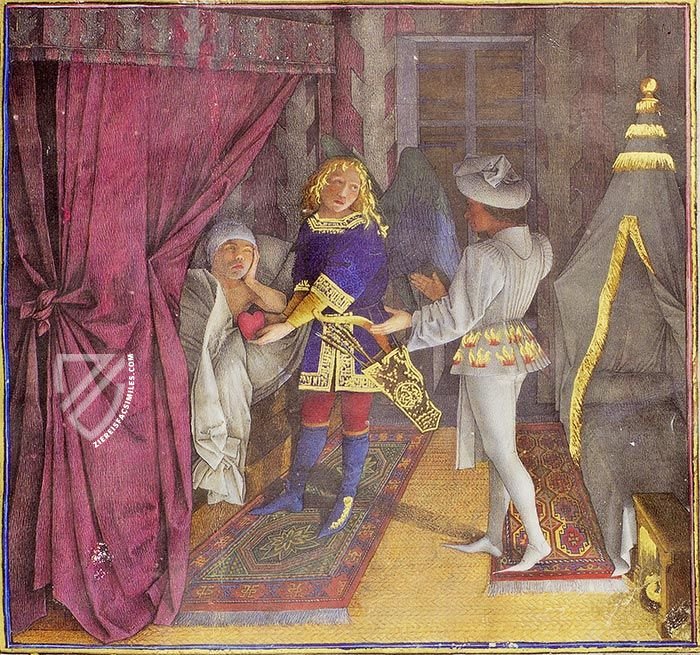
King René's Book of Love
The Pass of Perils
Barthélemy d'Eyck’s fantastic artistry is demonstrated in this miniature of the knight Cuer/Cœur (heart), his squire Désir (burning desire), and Melancholy, personified by a gray haired woman in a black dress, approach a bridge at Le pas Perilleux. It is guarded by the knight Soulcy, who is ominously dressed in black armor and mounted in a black horse, which is itself clad in black.
The protagonists strike quite a contrast to this dark challenger: the knight Cuer wears a beautiful suit of armor with a great helm adorned with flowers and wings of red and gold, his squire Désir is dressed all in white. Aside from the wonderful color palette, this miniature demonstrates d’Eyck’s attentions to detail, especially in the depiction of clothing and armor.
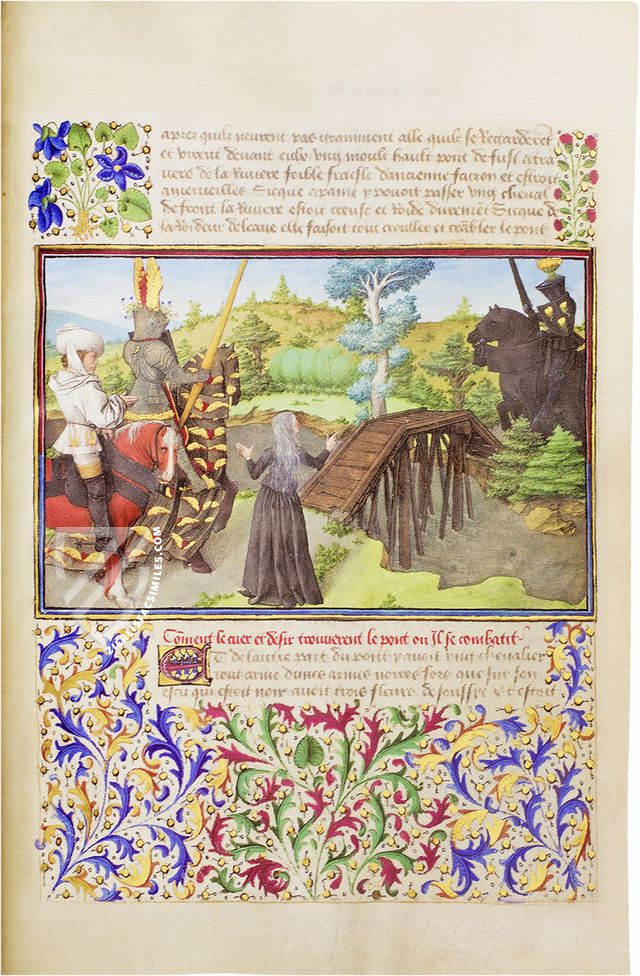
#1 El libro del corazón prendido
Language: Spanish
(3,000€ - 7,000€)
#2 Von Rittermut und Liebe
Language: German
(3,000€ - 7,000€)
#3 King René's Book of Love
Languages: English, German
(under 1,000€)
- Treatises / Secular Books
- Apocalypses / Beatus
- Astronomy / Astrology
- Bestiaries
- Bibles / Gospels
- Chronicles / History / Law
- Geography / Maps
- Saints' Lives
- Islam / Oriental
- Judaism / Hebrew
- Single Leaf Collections
- Leonardo da Vinci
- Literature / Poetry
- Liturgical Manuscripts
- Medicine / Botany / Alchemy
- Music
- Mythology / Prophecies
- Psalters
- Other Religious Books
- Games / Hunting
- Private Devotion Books
- Other Genres
- Afghanistan
- Armenia
- Austria
- Belgium
- Belize
- Bosnia and Herzegovina
- China
- Colombia
- Costa Rica
- Croatia
- Cyprus
- Czech Republic
- Denmark
- Egypt
- El Salvador
- Ethiopia
- France
- Germany
- Greece
- Guatemala
- Honduras
- Hungary
- India
- Iran
- Iraq
- Israel
- Italy
- Japan
- Jordan
- Kazakhstan
- Kyrgyzstan
- Lebanon
- Liechtenstein
- Luxembourg
- Mexico
- Morocco
- Netherlands
- Palestine
- Panama
- Peru
- Poland
- Portugal
- Romania
- Russia
- Serbia
- Spain
- Sri Lanka
- Sweden
- Switzerland
- Syria
- Tajikistan
- Turkey
- Turkmenistan
- Ukraine
- United Kingdom
- United States
- Uzbekistan
- Vatican City
- A. Oosthoek, van Holkema & Warendorf
- Aboca Museum
- Ajuntament de Valencia
- Akademie Verlag
- Akademische Druck- u. Verlagsanstalt (ADEVA)
- Aldo Ausilio Editore - Bottega d’Erasmo
- Alecto Historical Editions
- Alkuin Verlag
- Almqvist & Wiksell
- Amilcare Pizzi
- Andreas & Andreas Verlagsbuchhandlung
- Archa 90
- Archiv Verlag
- Archivi Edizioni
- Arnold Verlag
- ARS
- Ars Magna
- ArtCodex
- AyN Ediciones
- Azimuth Editions
- Badenia Verlag
- Bärenreiter-Verlag
- Belser Verlag
- Belser Verlag / WK Wertkontor
- Benziger Verlag
- Bernardinum Wydawnictwo
- BiblioGemma
- Biblioteca Apostolica Vaticana (Vaticanstadt, Vaticanstadt)
- Bibliotheca Palatina Faksimile Verlag
- Bibliotheca Rara
- Boydell & Brewer
- Bramante Edizioni
- Bredius Genootschap
- Brepols Publishers
- British Library
- C. Weckesser
- Caixa Catalunya
- Canesi
- CAPSA, Ars Scriptoria
- Caratzas Brothers, Publishers
- Carus Verlag
- Casamassima Libri
- Centrum Cartographie Verlag GmbH
- Chavane Verlag
- Christian Brandstätter Verlag
- Circulo Cientifico
- Club Bibliófilo Versol
- Club du Livre
- CM Editores
- Collegium Graphicum
- Collezione Apocrifa Da Vinci
- Comissão Nacional para as Comemorações dos Descobrimentos Portugueses
- Coron Verlag
- Corvina
- CTHS
- D. S. Brewer
- Damon
- De Agostini/UTET
- De Nederlandsche Boekhandel
- De Schutter
- Deuschle & Stemmle
- Deutscher Verlag für Kunstwissenschaft
- DIAMM
- Droz
- E. Schreiber Graphische Kunstanstalten
- Ediciones Boreal
- Ediciones Grial
- Ediclube
- Edições Inapa
- Edilan
- Editalia
- Edition Deuschle
- Edition Georg Popp
- Edition Leipzig
- Edition Libri Illustri
- Editiones Reales Sitios S. L.
- Éditions de l'Oiseau Lyre
- Editions Medicina Rara
- Editorial Casariego
- Editorial Mintzoa
- Editrice Antenore
- Editrice Velar
- Edizioni Edison
- Egeria, S.L.
- Eikon Editores
- Electa
- Emery Walker Limited
- Enciclopèdia Catalana
- Eos-Verlag
- Ephesus Publishing
- Ernst Battenberg
- Eugrammia Press
- Extraordinary Editions
- Fackelverlag
- Facsimila Art & Edition
- Facsimile Editions Ltd.
- Facsimilia Art & Edition Ebert KG
- Faksimile Verlag
- Feuermann Verlag
- Folger Shakespeare Library
- Franco Cosimo Panini Editore
- Friedrich Wittig Verlag
- Fundación Hullera Vasco-Leonesa
- G. Braziller
- Gabriele Mazzotta Editore
- Gebr. Mann Verlag
- Gesellschaft für graphische Industrie
- Getty Research Institute
- Giovanni Domenico de Rossi
- Giunti Editore
- Graffiti
- Grafica European Center of Fine Arts
- Guido Pressler
- Guillermo Blazquez
- Gustav Kiepenheuer
- H. N. Abrams
- Harrassowitz
- Harvard University Press
- Helikon
- Hendrickson Publishers
- Henning Oppermann
- Herder Verlag
- Hes & De Graaf Publishers
- Hoepli
- Holbein-Verlag
- Houghton Library
- Hugo Schmidt Verlag
- Idion Verlag
- Il Bulino, edizioni d'arte
- ILte
- Imago
- Insel Verlag
- Insel-Verlag Anton Kippenberger
- Instituto de Estudios Altoaragoneses
- Instituto Nacional de Antropología e Historia
- Introligatornia Budnik Jerzy
- Istituto dell'Enciclopedia Italiana - Treccani
- Istituto Ellenico di Studi Bizantini e Postbizantini
- Istituto Geografico De Agostini
- Istituto Poligrafico e Zecca dello Stato
- Italarte Art Establishments
- Jan Thorbecke Verlag
- Johnson Reprint Corporation
- Josef Stocker
- Josef Stocker-Schmid
- Jugoslavija
- Karl W. Hiersemann
- Kasper Straube
- Kaydeda Ediciones
- Kindler Verlag / Coron Verlag
- Kodansha International Ltd.
- Konrad Kölbl Verlag
- Kurt Wolff Verlag
- La Liberia dello Stato
- La Linea Editrice
- La Meta Editore
- Lambert Schneider
- Landeskreditbank Baden-Württemberg
- Leo S. Olschki
- Les Incunables
- Liber Artis
- Library of Congress
- Libreria Musicale Italiana
- Lichtdruck
- Lito Immagine Editore
- Lumen Artis
- Lund Humphries
- M. Moleiro Editor
- Maison des Sciences de l'homme et de la société de Poitiers
- Manuscriptum
- Martinus Nijhoff
- Maruzen-Yushodo Co. Ltd.
- MASA
- Massada Publishers
- McGraw-Hill
- Metropolitan Museum of Art
- Militos
- Millennium Liber
- Müller & Schindler
- Nahar - Stavit
- Nahar and Steimatzky
- National Library of Wales
- Neri Pozza
- Nova Charta
- Oceanum Verlag
- Odeon
- Orbis Mediaevalis
- Orbis Pictus
- Österreichische Staatsdruckerei
- Oxford University Press
- Pageant Books
- Parzellers Buchverlag
- Patrimonio Ediciones
- Pattloch Verlag
- PIAF
- Pieper Verlag
- Plon-Nourrit et cie
- Poligrafiche Bolis
- Presses Universitaires de Strasbourg
- Prestel Verlag
- Princeton University Press
- Prisma Verlag
- Priuli & Verlucca, editori
- Pro Sport Verlag
- Propyläen Verlag
- Pytheas Books
- Quaternio Verlag Luzern
- Reales Sitios
- Recht-Verlag
- Reichert Verlag
- Reichsdruckerei
- Reprint Verlag
- Riehn & Reusch
- Roberto Vattori Editore
- Rosenkilde and Bagger
- Roxburghe Club
- Salerno Editrice
- Saltellus Press
- Sandoz
- Sarajevo Svjetlost
- Schöck ArtPrint Kft.
- Schulsinger Brothers
- Scolar Press
- Scrinium
- Scripta Maneant
- Scriptorium
- Shazar
- Siloé, arte y bibliofilia
- SISMEL - Edizioni del Galluzzo
- Sociedad Mexicana de Antropología
- Société des Bibliophiles & Iconophiles de Belgique
- Soncin Publishing
- Sorli Ediciones
- Stainer and Bell
- Studer
- Styria Verlag
- Sumptibus Pragopress
- Szegedi Tudomànyegyetem
- Taberna Libraria
- Tarshish Books
- Taschen
- Tempus Libri
- Testimonio Compañía Editorial
- Thames and Hudson
- The Clear Vue Publishing Partnership Limited
- The Facsimile Codex
- The Folio Society
- The Marquess of Normanby
- The Richard III and Yorkist History Trust
- Tip.Le.Co
- TouchArt
- TREC Publishing House
- TRI Publishing Co.
- Trident Editore
- Tuliba Collection
- Typis Regiae Officinae Polygraphicae
- Union Verlag Berlin
- Universidad de Granada
- University of California Press
- University of Chicago Press
- Urs Graf
- Vallecchi
- Van Wijnen
- VCH, Acta Humaniora
- VDI Verlag
- VEB Deutscher Verlag für Musik
- Verlag Anton Pustet / Andreas Verlag
- Verlag Bibliophile Drucke Josef Stocker
- Verlag der Münchner Drucke
- Verlag für Regionalgeschichte
- Verlag Styria
- Vicent Garcia Editores
- W. Turnowski Ltd.
- W. Turnowsky
- Waanders Printers
- Wiener Mechitharisten-Congregation (Wien, Österreich)
- Wissenschaftliche Buchgesellschaft
- Wissenschaftliche Verlagsgesellschaft
- Wydawnictwo Dolnoslaskie
- Xuntanza Editorial
- Zakład Narodowy
- Zollikofer AG

